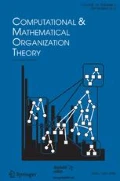Abstract
Agent-based modeling has been well received in the simulation community. Complex systems are simulated by many autonomous agents whose behavior is defined by a conceptual model. However, the model can be improperly implemented or misinterpreted resulting in an implementation that does not reflect the conceptual rules. It is imperative that the implementation’s function be tested against the model’s expected outcome. In this paper, we present certain steady-state techniques that can be used to verify the operation of agent-based simulations. These methods are introduced and then applied to an ecological model which simulates reproductive dynamics of mosquitoes.









Similar content being viewed by others
References
Awad HP, Glynn PW (2006) On an initial transient deletion rule with rigorous theoretical support. In: Proceedings of the winter simulation, pp 186–191
Axelrod R, Axtell R, Epstein J, Cohen M (1996) Aligning simulation models: a case study and results. Comput Math Organ Theory 1:123–141
Balci O (2001) A methodology for certification of modeling and simulation applications. ACM Trans Model Comput Simul 11(4):352–377
Bordini R, Fisher M, Visser W (2006) Verifying multi-agent programs by model checking. Auton Agents Multi-Agent Syst 2:239–256
Chan WKV (2008) An analysis of emerging behaviors in large-scale queueing-based service systems using agent-based simulation. In: Proceedings of the 40th conference on winter simulation, pp 872–878
Crawley J (2004) Reducing the burden of anemia in infants and young children in malaria-endemic countries of Africa: from evidence to action. Am J Trop Med Hyg 71(2 suppl):25
Gentile J, Rund S (2011) A framework for modeling genetically-aware mosquito vectors for sterile insect technique. Int J Agent Technol Syst 3:49–65
Grimm V (2002) Visual debugging: a way of analyzing, understanding and communicating bottom-up simulation models in ecology. Nat Resour Model 15(1):23–38
Gu W, Novak RJ (2009a) Agent-based modelling of mosquito foraging behaviour for malaria control. Trans R Soc Trop Med Hyg 103(11):1105–1112
Gu W, Novak R (2009b) Predicting the impact of insecticide-treated bed nets on malaria transmission: the devil is in the detail. Malar J 8(1):256
Hu A, San Y, Wang Z (2001) Verifying and validating a simulation model. In: Proceedings of the 33rd conference on winter simulation, pp 595–599
Kefalas P, Holcombe Eleftherakis G, Gheorghe M (2003) Intelligent Agent Software Engineering, Chapter A. Formal Method for the Development of Agent-Based Systems, pages 68–98. Idea Group Publishing
Kendall G, Su Y (2003) The co-evolution of trading strategies in a multi-agent based simulated stock market through the integration of individual learning and social learning. In: Proceedings of IEEE 2003 congress on evolutionary computation (CEC’03), pp 2298–2305
Kleijnen JPC (1995) Verification and validation of simulation models. Eur J Oper Res 82(1):145–162
Marsella SC, Pynadath DV, Read SJ (2004) Psychsim: agent-based modeling of social interactions and influence. In: Proceedings of the international conference on cognitive modeling, pp 243–248
Munga S, Minakawa N, Zhou G, Barrack O-OJ, Githeko AK, Yan G (2006) Effects of larval competitors and predators on oviposition site selection of anopheles gambiae sensu stricto. J Med Entomol 43(2):221–224
Nicholson A (1933) Supplement: the balance of animal populations. The Journal of Animal Ecology, 131–178
Patt A, Siebenhüner B (2002) Agent based modeling and adaptation to climate change. Vierteljahrsh. Wirtschaftsforsch. 74(2):310–320
Rateb F, Pavard B, Bellamine-BenSaoud N, Merelo JJ (2005) Modeling malaria with multi-agent systems. Int J Intell Inf Technol 1(2):17–27
Ropella G, Railsback S, Jackson S (2002) Software engineering considerations for individual-based models. Natural Resource Modeling, 5–22
Styer LM, Carey JR, Wang JL, Scott TW (2007) Mosquitoes do senesce: departure from the paradigm of constant mortality. Am J Trop Med Hyg 76(1):111
Tuncer O (2001) Impact of data on simulation: from early practices to federated and agent-directed simulation. In: Proceedings of the EUROSIM
Author information
Authors and Affiliations
Corresponding author
Rights and permissions
About this article
Cite this article
Gentile, J.E., Davis, G.J. & Rund, S.S.C. Verifying agent-based models with steady-state analysis. Comput Math Organ Theory 18, 404–418 (2012). https://doi.org/10.1007/s10588-012-9128-8
Published:
Issue Date:
DOI: https://doi.org/10.1007/s10588-012-9128-8



